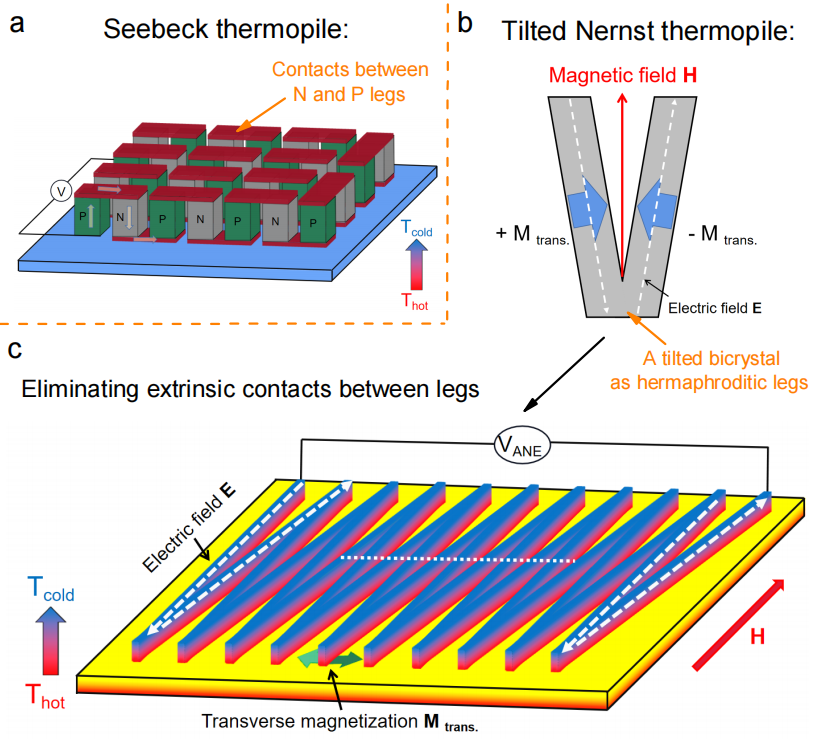
Fig.1: (a) A Seebeck thermopile has a vertical structure and is made of two different types of materials labelled N and P. (b) The tilted Nernst thermopile proposed by us, with a tilted bicrystal as the elemental brick (top). In which we expect to automatically alternate the direction of magnetization between adjacent elements by using the transverse magnetization instead of the longitudinal magnetization.

Fig.2: Proof of concept: (a) Top: Photograph of the experimental setup for the tilted Nernst thermopile. Bottom: Photograph of an array of tilted Mn3Sn crystals. (b) Six different Nernst hysteresis curves, which were measured from different electrodes. (c) The extracted Nernst signal is proportional to the number of crystal. The average aspect ratio of crystals in this experiments is 3.4.
Background
Direct conversion of heat to electricity thanks to thermoelectric devices is an environmental friendly technology for recovery of ever-increasing waste heat and heat sensing. The traditional approach, based on using the longitudinal thermoelectric (Seebeck or magneto-Seebeck) effect, has generated a vast research activity. However, a typical Seebeck thermopile consists of an array of linked thermocouples, each consisting of two different types of thermoelectric materials, labelled as N and P legs, and has a vertical pillar structure (See Fig1.a). It requires numerous contacts between N and P legs, which dissipates the energy. Moreover, the complicated pillar structure is costly and could hamper the flexibility and endurance of the device. The contact issue together with the cost and complexity of assembly process have limited the wide spread use of Seebeck thermopiles.
What we discover?
Firstly, in this work, Prof. Zhu’s group design and build a newly thermopile with an array of tilted adjacent crystals of Mn3Sn, using its anomalous Nernst effect (ANE). which is called as the tilted Nernst thermopile, and employs a single material and replaces pairs of P and N thermocouples of the traditional design with hermaphroditic legs (See Fig1.b). Secondly, we expect the voltage signals to add up linearly and boundlessly with the addition of a new elemental brick, and we have realized this in our proof experiment (See Fig2). Moreover, we find that the large lag angle between the applied field and the magnetization, which we attribute to the interruption of magnetic octupoles at the edge of xy-plane, is the origin of the transverse magnetization exploited in our design.
Why is this important?
This work proposes and realizes a new mono-material Nernst thermopile with hermaphroditic legs. This design has a number of obvious advantages compared to the traditional thermopiles. Such as, eliminating extrinsic contacts between legs will boost the efficiency, simplifying the process will pave the way for a new generation of thermopiles.
Who did the research?
Xiaokang Li1,*, Zengwei Zhu1,* and Kamran Behnia2
(1) Wuhan National High Magnetic Field Center and School of Physics, Huazhong University of Science and Technology, Wuhan 430074, China.
(2) Laboratoire de Physique et d’Etude de Matériaux (CNRS-Sorbonne Université), ESPCI, PSL Research University, 75005 Paris, France.
Funding
This work was supported by the National Science Foundation of China (Grant No. 11574097 and No. 51861135104) and The National Key Research and Development Program of China (Grant No.2016YFA0401704). This work was supported in France by the Agence Nationale de la Recherche (ANR-18-CE92-0020-01; ANR-19-CE30-0014-04). X. L. acknowledges the China National Postdoctoral Program for Innovative Talents (Grant No.BX20200143) and the China Postdoctoral Science Foundation (Grant No.2020M682386).
